
Life and Development of Russian Crafts
From Kadom embroidery to Pavlovo Posad shawls, today we are going to tell our readers about the traditional Russia crafts, their interesting features, the course of development and their place in the world of contemporary design and fashion. We are also about to tell you about some peculiar collaboration and about the modern life of some Russian crafts in general.
Pavloposadskiye shawls
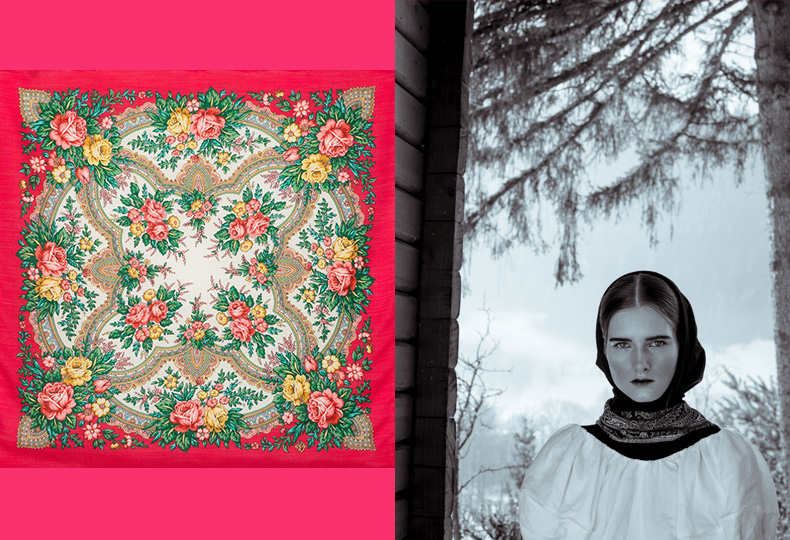
LEFT: THE SHAWL TITLED ‘ERUPTION OF JOY’ WITH DECORATIVE PATTERN DESIGNED BY YEVGENIYA MURAVYEVA. RIGHT: VERONIKA RUSAKOVA DURING PHOTO SESSION BY ELIZAVETA PORODINA FOR VOGUE UA, JANUARY 2017.
The complicated patterns of the Pavlovo Posad shawls make them as recognizable as the iconic Hermes scarves. By the way, the quality, size and materials area also pretty similar. The shawl factory was founded in Pavlovo village back in 1795, but the production of woolen shawls with printed patterns started there only around half century later. Before 1970, the floral patterns and prints had been applied on the shawls sing the wooden cut gouges pressed against each shawl few hundred times. Now, the technological process has been facilitated significantly, but every pattern is still designed by the artists by hand. The Pavlovo Posad shawls have established a foothold on the pages of fashion magazines, such as Vogue. Last year, at the forefront of the FIFA World Cup, the Aizel store launched collaboration ith more than 20 designers. The traditional Russian crafts, including the Pavlovo Posad shawl factory, also took part in the project.
Orenburg Downy Shawls
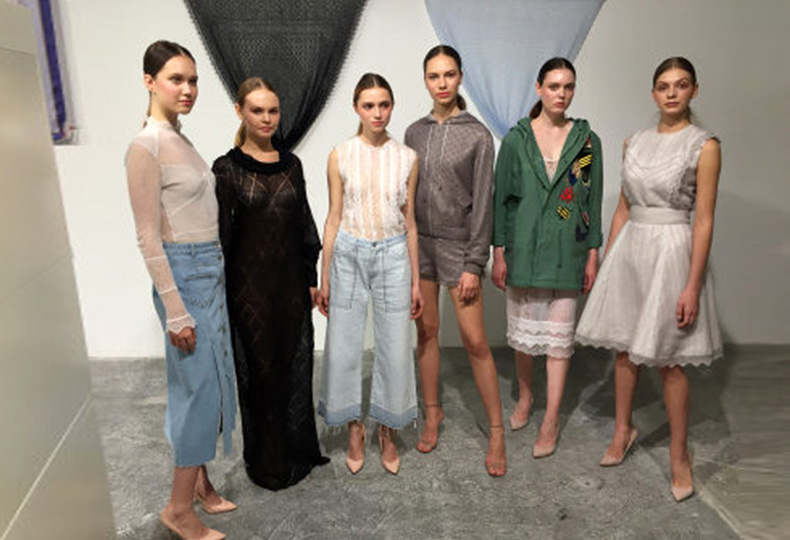
VALENTIN YUDASHKIN AND ORENBURG SHAWL FACTORY
The history of this finest down shawl factory extends for more than 250 years, when the Europe first saw the Orenburg shawls in 1862 at the exhibition in London. The peculiar signatory feature of these shawls is the finest down produced from the Orenburg goat wool and used to knit the delicate, almost weightless lace. Actually, the originality of the shawl may be easily checked by pulling it through the ring. This ancient craft attracts many modern fashion designers including Valentin Yudashkin, who presented the silk dress covered with fine spider web-like lace back in 1996 in Paris. Around two years ago, he announced another collaboration with Orenburg Shawl Factory and released the new collection of dresses, sweatshirt and tops from white spun filament.
Krestetsky Embroidery
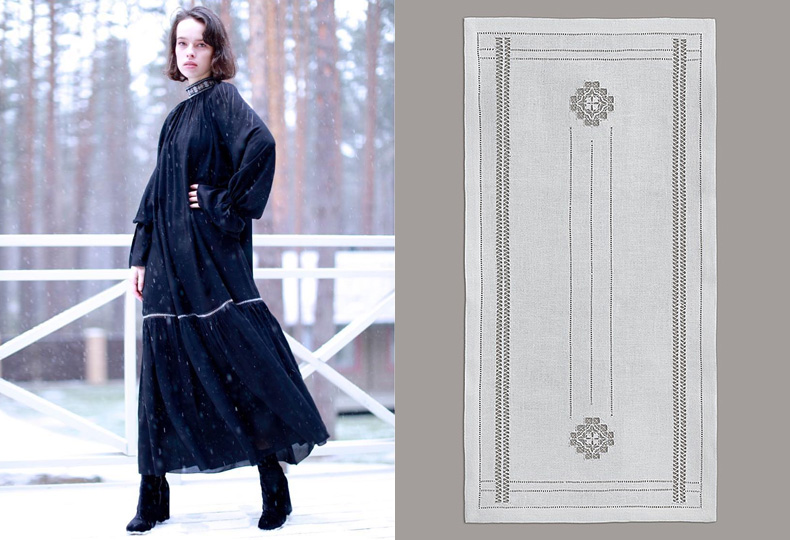
LEFT: THE DRESS WITH KRESTETSKY EMBROIDERY FROM ALEXANDRA GEORGIYEVA’S COLLECTION. RIGHT: TABLECLOTH DECORATED WITH KRESTETSKY EMBROIDERY
Krestetsky embroidery is the peculiar Russian art of embroidery using the through-thickness embroidery technique that originated in 1860s years in Krestetsky District. During USSR era, Krestetsky embroidery also remained popular, and the tablecloths with reserved aristocratic, but distinctive embroidery were often found almost in every home. In 2015, Krestetsky embroidery factory turned bankrupt and was acquired by the businessman Anton Georgiyev, and his wife, designer Alexandra Georgiyeva, who became the visionaries of famous traditional craft revival. Last year, at the Central Department Store, as part of the IV Russian Seasons event, Alexandra Georgiyeva presented her collection of modern dresses decorated with delicate Krestetsky embroidery. According to the designer, her main goal now is to make the Krestetsky embroidery that has been easily recognizable for more than 150 years, to remain such in the future.
Kadom Embroidery
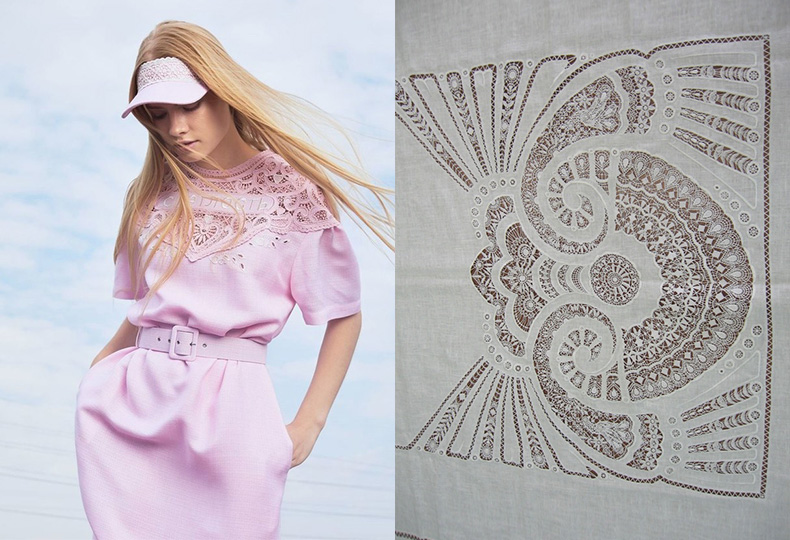
LEFT: SERENITY BY EKATERINA PETROVA; RIGHT: KADOM EMBROIDERY
Kadom embroidery is very special technique on the edge between lace knitting and white-on-white needle embroidery. This craft originated back in the age of Petr I, who ordered his noblemen to wear the garments decorated with the Venetian lace. The ruler even brought to Russia several craftswomen to teach the Kadom Convent nuns their craft. The process of working with Kadom embroidery technique differs significantly from conventional lace bobbin knitting, so resulting patterns are absolutely unique. Ekaterina Petrova is the modern Russian fashion designer who focuses on Kadom embroidery and last summer released her Serenity collection in collaboration with Kadom factory.
Zhostovo trays
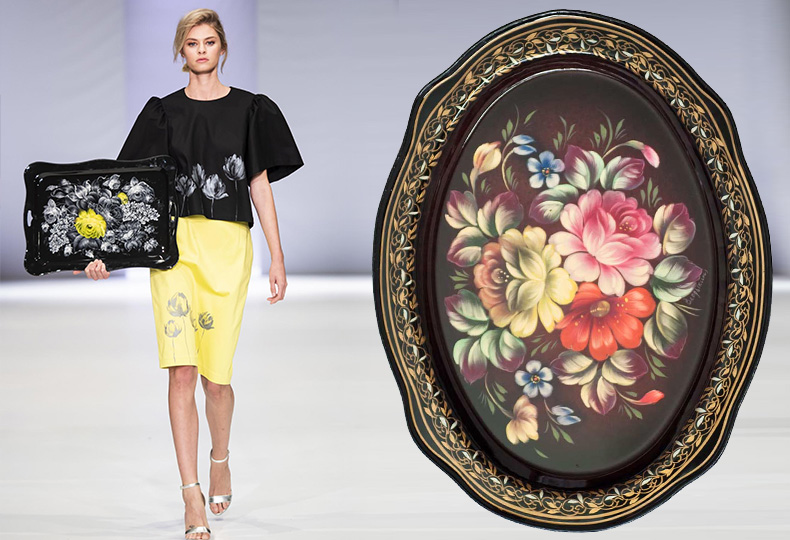
LEFT: FASHION SHOW BY SERGEY SYSOEV, SPRING – SUMMER 2019; RIGHT: ZHOSTOVO TRAY.
The history of Zhostovo trays dates back to XVIII, when former bondman opened his craft shop in the small Zhostovo village not far from Moscow. Besides from trays, he also made cassettes, tobacco boxes and other lacquered things, but from papier-mache rather than metal. The production of metal trays started only in around 30 years. Today, the trays factory still operates in Zhostovo, where each item is painted by hand with traditional bright roses, tulips and dahlias. Recently, Russian fashion designer Sergey Sysoyev presented his tray collection created in collaboration with Zhostovo factory. He decided to preserve the conventional floral pattern, but replaced the bright colors with rather monochrome ones.
Gzhel
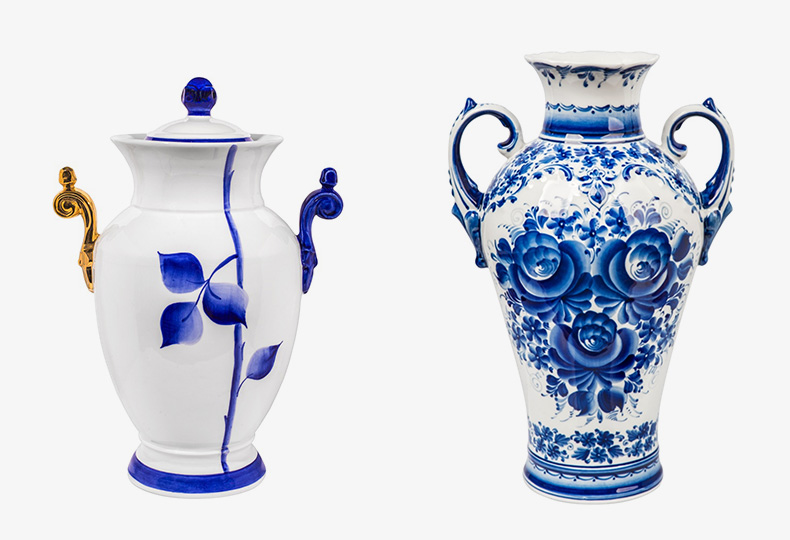
LEFT: JAR BY SERGEY SYSOYEV FOR GZHEL PORCELAIN FACTORY; RIGHT: TRADITIONAL HAND-PAINTED VASE TITLED VALENTINA.
Gzhel Porcelain Factory is one of the most daring traditional manufacturers in terms of unusual collaborations. The company sees the cooperation with popular designers as a way to modernize the traditional Gzhel ceramics, make it relevant and interesting not only for older generation customers, but also for the modern elite buyers. The collection of Gzhel dishware designed by Diana Balashova was the first experience of collaboration with modern designer for factory. Therefore, Balashova decided to abstain from too risky and trenchant ideas and came up with Astrakhan plate series decorated with sturgeon images. Last year, Gzhel Porcelain Factory announced another collaboration, but this time with Sergey Sysoyev, who designed the porcelain collection with traditional decorative patterns, such as roses, zig-zags and wheat spike, while supplementing the traditional blue color with gold.

